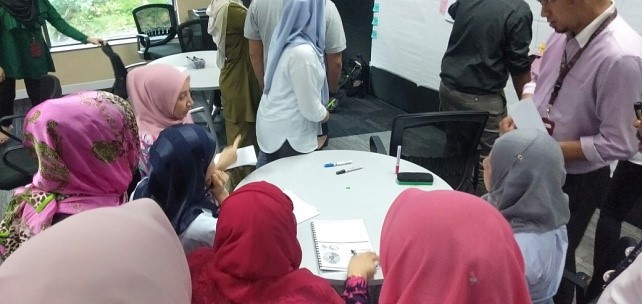PROCESS EXCELLENCE PROGRAMME
(Government Agency)
SUMMARY
On the 10th, 11th and 13th of February 2020, as interns of MBizM Group, we were assigned to attend a process improvement simulation organized by MBizM Group which was held at a government agency. The participants consist of 27 to 30 staff members from various divisions throughout the three separate sessions. The “Process Excellence Programme” is generally a whole-day programme from 9am until 6pm, in which focuses on introducing the participants on the methodologies that they can apply to achieve ‘Process Improvement’ in the division.


INTRODUCTIONS
The programme was handled by three of MBizM Group’s consultants; Dr. Muraliraj, Mr. Mohammad Faisal and Miss Wong Sze Yin as well as us fellow interns. The programme was situated at the agency’s Training Room and before the programme starts, all three consultants began to prepare materials for the participants and presentation. Dr. Muraliraj, as the speaker, introduced himself and the other consultants of MBizM Group. Then, an ice breaking session was carried out where each participant are asked to introduce one person around him/her such as their name, division/department and past experience in process improvement.
MORNING TALK
Once introductions were done, Dr. Muraliraj started on the importance of ‘Process Improvement’ which is the theme of the talk. Here, he explained how an organization can only achieve dynamic organizational capability by having better processes. To illustrate, he stated that processes synthesize factors like performance, financial health, budgetary allocation, workforce, technology and infrastructure, which will ensure better organizational capability as well as organization’s vision and mission realization. Furthermore, participants were also taught how an organization is composed of a network of routines and efficient processes are important. One interesting quote from Dr. Muraliraj that I have recorded is “With bad processes come bad mistakes that may cost millions and time”. Moreover, he also taught how culture resides in a person’s mindset that determines a person’s behaviour which in turn influence a community’s behaviour and way of thinking. This concept can be applied to an organization where an organization’s routine or culture can only be changed by engaging in something consistently.


Dr. Muraliraj introducing “Process Improvement”
SIMULATION
Before the simulation started, the participants were divided into two groups that represent their divisions of QS Finance. Members of the divisions are given their respective roles and they are asked to follow the descriptions that came with the roles, while eight of them who volunteered played the role of ‘customers’. The simulation consists of 4 rounds where in each round, a certain period of time is given and after every round, the time is reduced. Here, both divisions need to compete and complete their tasks as fast and accurate as possible since at the end of each round, an evaluation session is carried out where the consultants calculate the profits and losses of each division. Moreover, after every round, both divisions need to improve the process of their task to reduce processing time and meet customers’ demand and satisfaction. This simulation expects every member of each division to work together since all play a crucial role to achieve sustainability in their processes leading towards establishing an organization capability that is agile.


Participants discussing and working together during the simulation
EVENING TALK
As the final rounds came closer, Dr. Muraliraj first taught on the methodologies that may help the participants have an idea on how to improve their processes in meeting customers’ demand more efficiently. Using the ‘Swimlane Diagram’, he introduced the approaches and applications of ‘Business Process Management’ (BPM) that consists of Designing, Modelling, Executing, Monitoring, and Optimizing, as well as ‘Value Analysis’ that involves Value Adding (what customer is willing to pay), Value Enabling (necessary to help gain value adding activities) and Non-Value Adding (what customer are not willing to pay and not necessary for process staff). Not only that, participants also learned how to detect non-value adding tasks through the TIMWOOD (Transportation, Inventory, Motion, Waiting, Over-Processing, Over-Production, and Defect) Approach.


Dr. Muraliraj introducing the ‘Swimlane Diagram’
CONCLUSION
After all rounds are done and both divisions’ process performance were evaluated, it can be proven that the simulations for all three sessions were a success as all divisions for the sessions gained new momentum by showing great improvement at the end of the simulations. In addition, it can be seen that participants have experienced an enjoyable time during the simulation while also gained new perspective in improving their work process flow much more efficiently and effectively without consuming any unnecessary time and cost. This will likely be a great help to them for their work at their agency.




Logos created by the participants for their divisions in the simulation ice-breaking session.
Prepared by;
Aizatul Aisyah Binti Mohd Idris
Date: 11/03/2020 (Wednesday)
Photos taken by;
Najah Nasirah Binti Mohd Lutfi (6th session)
Nur Arfa Iwana Binti Sarikhuddin (7th session)
Aizatul Aisyah Binti Mohd Idris (8th session)


